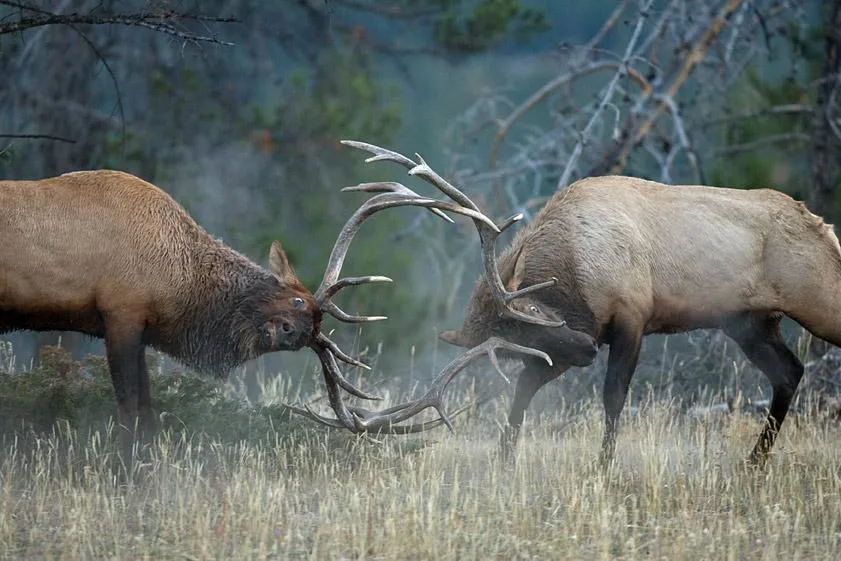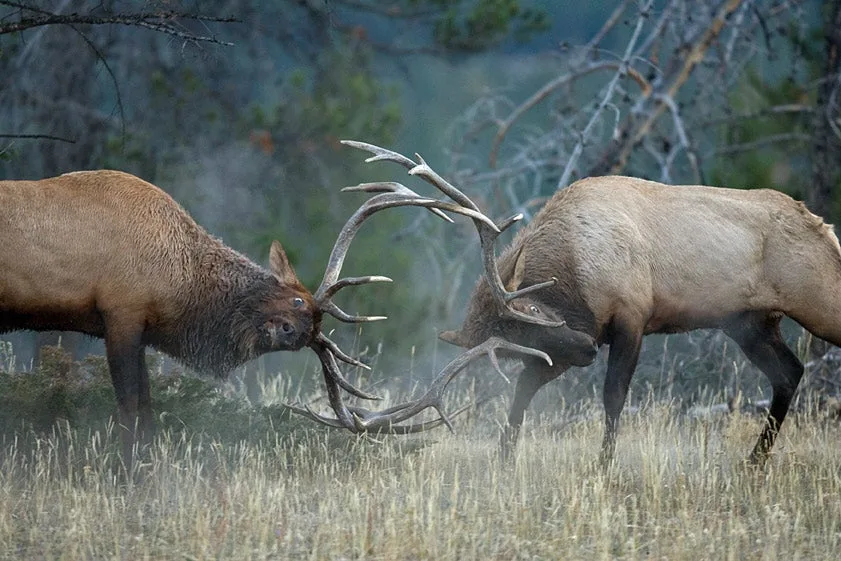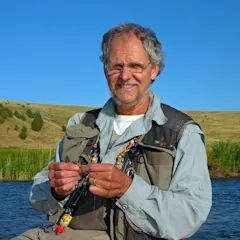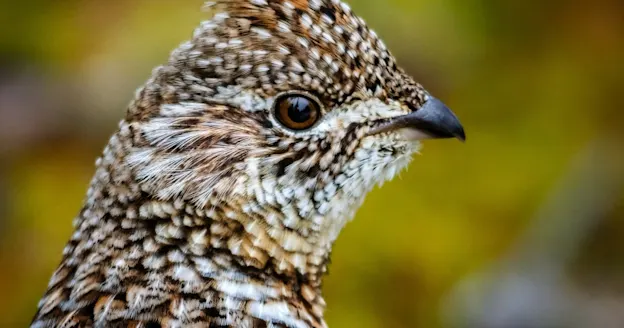
Two bulls battle it out. Field & Stream
The kings of the deer family thrive on large ranges of land. Many public areas offer plenty of room for both elk and the hunters who roam for them.
1. Oregon – Siuslaw National Forest
Roosevelt elk are overlooked by most hunters, but there are plenty of over-the-counter tags available for two seasons in western Oregon. The Siuslaw and Alsea units in the Siuslaw National Forest present good chances for hunters who are willing to do a little legwork and put up with a lot of rain.
2. Montana – Beaverhead-Deerlodge National Forest
Fifty percent of the elk harvest comes from Region 3 in the southwest part of the state. The forest outside Dillon, which encompasses several mountain ranges, affords elk security cover while also providing numerous hunter-access points.
3. Colorado – White River National Forest:
It’s heavily hunted, but there’s good access and a healthy elk population. Some bigger bulls live in the Flat Tops Wilderness Area of this tract, but it’s all thin air and you can get snow up to your knickers very quickly here.
4. New Mexico – Cibola National Forest, Santa Fe National Forest
Low-percentage, limited-draw hunts are the rule in New Mexico, but big bulls are the prize. Tags for the Zuni Mountains and Mount Taylor areas in Cibola and in the Jemez area in Santa Fe are a bit easier to draw than the coveted tags in the Gila National Forest to the south.
5. Idaho – St. Joe National Forest
Historically, this forest in the southern Panhandle region is among the best places in any state to score with a bow, with the adjoining Clearwater National Forest just as good. You’ll need either a GPS or a lot of iron in your brain to keep from getting lost in these deep woods, but you won’t have to worry about trespassing.
6. Wyoming – Bridger-Teton National Forest
Near Jackson, the forest allows access to some of the prettiest alpine basin country in the world. And there are elk here, too, lots of them. Good lungs and bear spray are prerequisites.
7. Wyoming – Shoshone National Forest
Also in the Cowboy State, the Beartooth Mountains offer classic wilderness elk hunting. There are good populations of bulls in big country all along the North Fork of the Shoshone River and Sunlight Basin.
8. Arizona – Coconino National Forest
All motor traffic is prohibited in the forest’s Pine Grove and Rattlesnake Quiet Areas in 6A, dissuading some hunters from going after what are among the biggest bulls on the planet.
9. Washington Wenaha-Tucannon Wilderness
After lean years due to unlimited tags, forest fires, and mountain lion predation, bull elk ratios are finally on the upswing in the famous Blue Mountains hunting grounds of southeast Washington. Over-the-counter tags restrict hunters to spikes, but if you draw a coveted any-bull tag, you’ll have a chance for a trophy in the roadless areas in this section of the Umatilla National Forest.
10. Utah – Ashley National Forest
The new world-record elk was taken last season on public land in Utah. The state vies with Arizona for the best public-land elk hunting, and residents sometimes find a plentiful supply of undrawn tags, including spike-bull permits. The two Uinta Mountains units in this forest are good choices among any bull areas, but no Utah tag is less than superb.
Pro Tips for Hunting Public Land Elk
Mark Seacat likens hunting on public lands to a game of chess—not one you play with the wapiti so much as with other hunters.
“Elk pattern off pressure,” the Montana hunter and former elk guide explains. “You have to know where the elk will go Sunday after being pressured on Saturday. By Tuesday they’ll start to settle down. I want to make a move to be in position to hunt them then.”Seacat shot his first elk when he was 12. Several years ago, he set a goal to take a mature bull off each of the half dozen mountain ranges visible from his hometown in western Montana. His game plan began by unfolding a map. “I would draw a circle around the public land in the mountain range. Then I’d start by checking out the middle of that circle in the middle of the week.”
This “mountaineering approach to elk hunting,” as Seacat terms it, often has the 30-year-old hunter crossing the spine of a range to work down to elk that have taken refuge on the more inaccessible side. In bow season, he’ll locate herds by running the ridgelines, glassing the basins, and listening for bulls bugling. Once he finds a herd, he’ll follow it, often for days while living out of his backpack. Because public-land bulls become call-shy compared with elk on lightly hunted private lands, he patterns the bull’s movements and ambushes or stalks it to get close enough for a shot.
When it’s time to trade broadheads for bullets, Seacat seeks out the toughest country he can find.
“Some pretty crazy bulls hang out in some pretty crazy places. They have to or they don’t get old,” he says.
For Seacat, the strategy of hunting areas where elk escape pressure has paid off with bulls from all but one of the ranges visible from town. Last season’s 6-point, which he arrowed after spotting 30 or more public-land bulls, is in the 370-class. He is already studying maps, hiking trails, and talking to taxidermists and hunting friends as he sets his sights on the public ranges just over the horizon.
My own approach is a variation of the same game, just one that is played on a smaller chessboard and with considerably older legs. I’ll map out the public trailheads on one front of a range, then link the access points with straight lines. The midpoints along these lines, between any two accesses, may not be too far back into the range, but the country will be tough to reach. What I am looking for are forested ridges that finger sharply down onto private ranches in the valleys. Hunting pressure from the ranches often creates a daily migration pattern, with the elk feeding on the ranchlands at night, then climbing back into thick timber on the public lands to bed during the day.
The downside of our hunting strategies? The first word out of our mouths after the elk goes down is uh-oh. Meat trips can require miles of up-and-down hiking under heavily loaded packs. The big 5-point my nephew shot last year took three of us two trips each to pack out, with round trips beginning at dawn and ending in moonlight.
“Fortunately and unfortunately, that’s the case,” Seacat agrees. “Most hunters limit themselves. They want an easy fix. But wild public lands give hunters who are willing to put their foot to the trail and work hard a great opportunity.”
Best public lands: National forests, wilderness areas.
Best opportunities: Limited-draw archery or rifle hunts that require years of applying to accumulate bonus points before a tag arrives in the mail. These hunts take place in areas that receive relatively light hunting pressure and have a deeper pool of mature bulls.
Look for: Security cover. Ranges that contain hard-to-reach, unroaded tracts of black timber will reward you with a better chance at larger bulls than heavily logged, easily accessible terrain, where opening-day harvest is high and elk don’t have much chance to grow up. Hunting is also likely to stay good longer into the season where there’s security cover.
Watch out for: Elk sanctuaries. On some ranges, elk have become so fine-tuned to hunting pressure that they migrate miles to (relatively) safe havens on private lands before the rifle season starts. Contact game managers to see if this is a concern and invest in a computer mapping program, so that you can preprogram your GPS with waypoints marking property boundaries. ––Keith McCafferty

Successful public-land hunters begin a long hike out. Steven Brutger
The Art of Stalking Elk on Public Land
The public lands of the West have blown open my mind and allowed inside a wild profusion of electrifying beauty, somber beauty, fecund beauty. The open spaces of the West—our prairies and badlands, and best of all, to my thinking, our mountain ranges and wilderness areas—have filled me with the most intense fragrances: mint, lupine, marsh sedges, and wild roses. And delicious tastes: venison, grouse, trout, morels, ducks, and the thing we pursue above all others, the animal that is bigger than a dream, elk.
Hunting them can be as imprecise as it is intense. There are basic laws of physics—pay attention to the wind, always, and the weather—but other than that, the hunt is wildly variable. Often, it is a matter of inches, and seconds. When hunters are chasing them, elk can vanish as if into another medium, steadily moving out ahead of you, and always playing the wind—either moving into it, and looking back over their shoulder, or with seeming paradox, hurrying on with the wind always at their back; this so they can always smell you behind them and calculate how fast to go, over the course of the autumn-short day, to stay just ahead of you.
Their tracks so fresh in the snow that individual pieces of hoof print still glisten, struck by the cold sun where the huge animals passed. Their splashes still wet upon the stones in the stream crossing. Their scent molecules ripe upon the foliage. You’re on them, but they are balancing space and time, weaving their lives out of these two things, having arisen as if from nothing more than the firmament and a hunter’s desire that there be such a thing as elk in this incredible landscape.
Space. I love following animals that are not bounded by fences. I love being able to walk for days on end, and not be bounded myself. It is in the West’s wild public lands—open to anyone who wishes to go in on foot and do things the hard way, the old way—that we experience one of the great underrated strengths of our country’s character: not just the presence of wildness but, as Wallace Stegner famously said, the idea of it—the knowledge that it is there. This creates in us an obligation and commitment to keep it big and wild.
I love to be able to follow elk to the horizon. They lead me into the most amazing places. Places I might not go on my own—to the bottoms of forested canyons and over high passes, breath-heaving, quad-burning, so you come to see that your legacy, the land that is yours, exists for as far as you can see; that wherever the wind blows or the sun falls, is your land.
Time. You have to cherry-pick. Time is on the elk’s side, not yours. Your season comes, then goes. The elk remain. For as long as there are mountains and wilderness for them to move into, leaving our puny selves behind, the elk remain. ––Rick Bass

Public Announcement: A heavy 7×7 bugles out across a wide drainage. Donald M. Jones
The Future of Elk Hunting on Public Lands
In 24 years of elk hunting, I’ve killed eight elk. Seven of them—including all three of my bulls—were on public land. The first bull, a 5×6, was high in the Bitterroot Mountains, in the Bitterroot National Forest, behind a ranch I was managing in 1991. I hunted that fall by shouldering a pack and a rifle and walking out from our cabin. I remember it as one of the greatest adventures of my life, leaving the swathers and the irrigation pipes behind and entering a vast world of elk, mule deer, and black bear, all of it free for the wandering.
That adventure has never ended. Although I love my native Alabama, I’ve raised my family in the West because of the freedom offered by our public lands. All Americans own a part of the greatest legacy of land the world has ever seen. We hold a 640-million-acre bastion of liberty that is the envy of a world growing more crowded and less free. If that seems too good to be true, that’s because it may prove to be so.
Right now, our public lands—where 72 percent of us hunt in the West and where almost all of the best D.I.Y. elk hunting on this planet takes place—are in the crosshairs of some misguided and truly shortsighted politicians. The first ruse is a demand to transfer public lands to control of the states, which have neither the budgets nor the incentives to keep or manage them, and which have already sold the majority of such lands granted to them at statehood. These politicians are counting on the anti–federal government fury that we all sometimes feel, to blind us to their real plans: the transfer and sell-off of the lands that belong to us all. If they succeed, we won’t just lose our public-land elk hunting. Federal water rights and grazing leases that underpin entire Western economies will be in play. We will face a radical remaking of our nation, bringing us in line with the landless citizens of China, Mexico, India, and most of Europe, where only the wealthiest hunt or fish or have access to wild country and clean rivers. It is not too late to stop this effort. Learn all you can, while we still have a chance to decide our own fate, and prepare for a battle.
And for heaven’s sake, get out there and enjoy your public lands. ––Hal Herring






